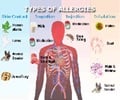Parents with allergic symptoms risk passing on their allergic sensitization to their infants too.
Parents with allergic symptoms like wheezing, asthma, hay fever or hives risk passing on their allergic sensitization to their infants too, according to a study by Cincinnati researchers.
The study suggests that the current practice of avoiding skin testing for airborne allergens before age 4 or 5 should be reconsidered, so children in this high-risk group can be detected early and monitored for the possibility of later allergic respiratory disease.Produced by scientists in UC’s departments of environmental health and internal medicine and at Cincinnati Children’s Hospital Medical Center, the study is reported in the October 2006 edition of The Journal of Pediatrics.
The Cincinnati researchers collected data on 680 children being evaluated for enrollment in the Cincinnati Childhood Allergy and Air Pollution Study (CCAAPS), sponsored by the National Institute of Environmental Health Sciences (NIEHS), and compared their results with findings in a 2004 Swedish study.
Using the skin-prick allergy test, the Swedish group found that in their general population—which included children whose parents did not suffer from allergies—7 percent had allergic sensitivity at age 1. The Swedes tested five allergens, two of which were food allergens.
The Cincinnati results, however, showed that 28.4 percent of infants born to “atopic” parents, defined as those with allergies, were sensitized to one or more airborne or food allergens. Eighteen percent were positive to one or more airborne allergens, and 13.7 percent were positive only to an airborne allergen.
According to UC epidemiologist Grace LeMasters, PhD, principal investigator for CCAAPS and the lead author of the report, the Cincinnati findings suggest that the potential for allergic disorders in infancy is underemphasized, “even though sensitization to allergens at younger ages has been shown to be more important than sensitization in late childhood for the development of wheezing symptoms and asthma.”
Advertisement
NLA











